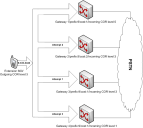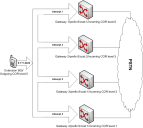Class of Restrictions (COR)
A COR is a set of limitations you apply to collections of extensions. The class of restrictions:
•Determines the numbers an extension can dial. For example, you can prevent extensions in a certain class from dialing external numbers, making long distance calls, etc.
•Determines the numbers to which an extension can transfer or forward calls. For example, you can prevent users in a certain class from transferring calls outside the system.
•Determines the numbers from which an extension can receive calls, including forwarded calls and transfers. For example, you can prevent extensions in a certain class from receiving external calls, calls from other internal departments, etc.
You can configure Ivanti Voice to load balance to a more expensive trunk if all the inexpensive trunks are taken. To do this, setup multiple gateways with the same COR, but assign different costs to each one. When a call with the COR enters the system, the SIP Soft Switch automatically routes the call to the least expensive gateway it finds.
Call Restriction Levels
CORs let you set incoming and outgoing call restriction levels, which determine the priority Ivanti Voice grants to extensions (including phones, trunks, and gateways) when allocating system resources. Extensions with an assigned outgoing call restriction level can only call extensions with an incoming call restriction level the same or lower. This enables you to reserve expensive resources (such as high-quality trunks) for certain extensions or subsets of users, such as company executives.
If there are multiple extensions to which Ivanti Voice can route the call, and each has an incoming call restriction level lower than the outgoing call restriction level of the calling extension, Ivanti Voice routes the call to the resource with the highest incoming call restriction level.
COR Process
1.A user places a call in the Ivanti Voice system.
2.Ivanti Voice checks the COR of the endpoint to verify the endpoint is not prohibited from making the call. If the COR prohibits the call, Ivanti Voice terminates the call; if the COR does not prohibit the call, Ivanti Voice continues with the next step.
3.Ivanti Voice checks the prefix of the number dialed and finds all gateways/trunks configured to handle that prefix.
4.Ivanti Voice narrows down the list of potential gateways/trunks to those with an incoming call level restriction that is equal to or less than the outgoing call level restriction of the caller’s COR.
5.Ivanti Voice routes the call to the remaining trunk/gateway with the highest incoming call level restriction.
If multiple gateways/trunks have the same incoming call restriction levels, Ivanti Voice uses the one with the lowest cost (if configured).
COR Examples
The following examples demonstrate how Ivanti Voice routes calls according to CORs. These examples use a sample environment with the following configuration:
•Phone A (outgoing call restriction level=5)
•Phone B (outgoing call restriction level=3)
•Gateway A (incoming call restriction level=5)
•Gateway B (incoming call restriction level=3)
•Gateway C (incoming call restriction level=2)
•Gateway D (incoming call restriction level=1)
Example 1:
Phone A places a call. Ivanti Voice tries to route the call to the gateways in the following order:
•Gateway A (incoming call restriction level = 5)
•Gateway B (incoming call restriction level = 3)
•Gateway C (incoming call restriction level = 2)
•Gateway D (incoming call restriction level = 1)
Example 2:
Phone B places a call. Ivanti Voice tries to route the call to the gateways in the following order:
•Gateway B (incoming call restriction level = 3)
•Gateway C (incoming call restriction level = 2)
•Gateway D (incoming call restriction level = 1)
Least-Cost Routing
When configuring prefixes for trunks and gateways, you can associate a cost with each prefix. That way, if your system has multiple trunks/gateways handling the same prefix, Ivanti Voice can compare the cost of each trunk/gateway for a dialed number with that prefix, and automatically route the call to the least expensive trunk/gateway. This is called least-cost routing.
Least-Cost Routing Process:
- A user places a call in the Ivanti Voice system.
- Ivanti Voice checks the COR of the endpoint to verify the endpoint is not prohibited from making the call. If the COR prohibits the call, Ivanti Voice terminates the call; if the COR does not prohibit the call, Ivanti Voice continues with the next step.
- Ivanti Voice checks the prefix of the number dialed and finds all gateways/trunks configured to handle that prefix.
- Ivanti Voice narrows down the list of potential gateways/trunks to those with an incoming call level restriction that is equal to or less than the outgoing call level restriction of the caller’s COR.
- Ivanti Voice routes the call to the remaining trunk/gateway with the highest incoming call level restriction. If there are multiple gateways/trunks with the highest incoming call level restriction, Ivanti Voice compares the costs of each and routes the call to the least expensive option.
Least-Cost Routing Examples
The following examples demonstrate how Ivanti Voice performs least-cost routing. These examples use a sample environment with the following configuration:
•Phone A (outgoing call restriction level=5)
•Phone B (outgoing call restriction level=3)
•Gateway A (incoming call restriction level=5, cost=4)
•Gateway B (incoming call restriction level=3, cost=2)
•Gateway C (incoming call restriction level=3, cost=1)
•Gateway D (incoming call restriction level=1, cost=1)
Example 1:
Phone A places a call. Ivanti Voice tries to route the call to the gateways in the following order:
•Gateway A (incoming call restriction level=5, cost=4)
•Gateway C (incoming call restriction level=3, cost=1)
•Gateway B (incoming call restriction level=3, cost=2)
•Gateway D (incoming call restriction level=1, cost=1)
Example 2:
Phone B places a call. Ivanti Voice tries to route the call to the gateways in the following order:
•Gateway C (incoming call restriction level=3, cost=1)
•Gateway B (incoming call restriction level=3, cost=2)
•Gateway D (incoming call restriction level=1, cost=1)
Least-Cost Routing Diagrams
The following diagrams illustrate how Ivanti Voice attempts to route a call from two sample extensions.
Create and Delete a COR
To Create a Restriction Class:
1.On the Management Portal menu window, click System Configuration > SIP Soft Switch > Restrictions. The Restrictions page opens.
2.In the empty field, type a name for the restriction.
3.Click Add. Configure the five tabs containing the COR settings.
To Delete a Restriction Class:
1.On the Management Portal menu window, click System Configuration > SIP Soft Switch > Restrictions.
2.Click the red x icon to the right of the COR.
3.Click OK to confirm the deletion.

